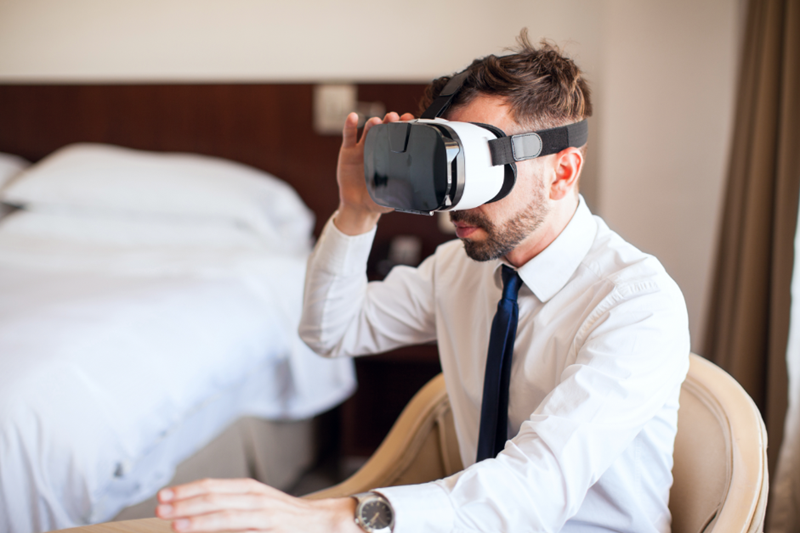Table of Contents
- Virtual Room and Property Tours
- Enhanced In-Room Entertainment
- AR Concierge Services
- Translation Assistance
- Virtual Art Galleries and Experiences
- Interactive Staff Training
- Tailoring AR and VR for Different Types of Hotels
As the hospitality industry becomes increasingly competitive, it’s crucial for properties to differentiate themselves to guests. Modern travelers are often seeking unforgettable experiences, not just a place to rest. To meet this demand, hotels can use Augmented Reality (AR) and Virtual Reality (VR) technologies to create immersive experiences that surprise and delight guests.
Recent data underscores the growing popularity of AR and VR. In 2022, a third of survey respondents said they would be “very interested” in using VR to tour a property before booking. This interest does translate into tangible results: Studies have also shown that offering virtual tours online can make travelers as much as two-thirds more likely to book online! Analyst forecasts note that the use of AR and VR in hospitality is expected to grow at a CAGR of 34.2% through 2028. This suggests that hotels need to incorporate these technologies to remain competitive.
In light of this striking growth, some well-known hotel brands (including Hilton, Hyatt, Best Western, Marriott, and Holiday Inn) and boutique hotels have embraced these immersive technologies to achieve a competitive advantage and improve the guest experience. Based on their successful implementations, here are some ways properties can use AR and VR to enhance the guest experience.
Virtual Room and Property Tours
As noted above, one of the most popular uses of VR is for room and property tours. Before booking online, guests can gain a 360° view of different room types and property features. Hotels can use these technologies to highlight amenities and unique aspects of the property, heightening guest interest. Hyatt Hotels and Marriott Hotels are some brands that have taken advantage of this approach.
Exploring accommodations and amenities before booking can help guests choose a hotel that best suits their needs. This is especially true for those booking event spaces. Virtual tours can make guests more enthusiastic about staying at a property and reduce the likelihood of dissatisfaction upon arrival. Immersive experiences can also make guests more likely to upgrade their room choice.
Once guests arrive, hotels can offer self-guided AR-enhanced tours of the local area. If the hotel has a noteworthy history, a tour of the property can enrich the guests’ stay and deepen their connection with the property.
Enhanced In-Room Entertainment
By adding AR and VR to traditional in-room entertainment, hotels can provide guests with unique and immersive experiences from the comfort of their rooms. They can enjoy virtual reality games, 360° videos, events, and immersive storytelling, adding a unique and memorable aspect to their stay. For example, Shangri-La Hotels and Resorts, a global luxury hotel chain, offers VR headsets, enabling guests to enjoy diverse experiences within their rooms.
AR Concierge Services
Hotels can use AR technology to provide interactive concierge services. For example, guests can use their mobile devices with a hotel’s app to access more detailed information about nearby attractions, restaurants, and events. AR maps can improve guest navigation within larger properties to locate amenities and event spaces. By overlaying information onto real-world environments, hotels can enhance guests’ experience and satisfaction during their stay.
Translation Assistance
Hotels can also use AR to provide translation assistance. For instance, guests can use their mobile devices and a hotel’s app to access real-time translations of nearby signage. This can remove a language barrier and help hotels serve more diverse guests. Also, guests may be more willing to book at a hotel that helps them navigate the property and its surroundings in their native language.

Virtual Art Galleries and Experiences
Hotels can create virtual art galleries using AR or VR, perhaps even featuring local artists. Guests can use their mobile devices to view artworks overlaid on physical spaces for a dynamic experience that can enhance the ambiance of common spaces such as lobbies and hallways. AR can also provide additional information about the creation and history of a physical artwork, enabling guests to learn more about a focal piece of interest.
Similarly, hotels can offer virtual experiences with local celebrities or other notable individuals. For example, Holiday Inn has used AR to enable guests with smartphones to view virtual representations of athletes and other celebrities who have stayed in the hotel. Hotels can offer immersive experiences where families can interact with their children’s favorite characters. Hotels can even schedule treasure hunts and other participatory events in the surrounding area. The possibilities are endless!
Not only can such experiences create a more memorable stay for guests, but they can also encourage guests to share those experiences on social media. Hotels can even tie this in with special promotions, such as social media contests, to encourage positive word-of-mouth for the brand.
Interactive Staff Training
AR and VR simulations for training are a great way to improve service quality and efficiency. They can encourage more effective learning by providing opportunities to practice in more realistic scenarios. For example, front desk staff can train on check-in procedures, and housekeeping teams can learn proper cleaning techniques and efficient methods.
Hilton Hotels has implemented AR and VR to help staff hone their skills and learn empathy to deliver exceptional service to guests. At Best Western, using VR in training led to a 71% drop in customer complaints and a 20% increase in satisfaction.
Some brands have even used VR in recruiting. For example, Hyatt Hotels has used a gamified VR app to give potential applicants a better idea of what a career in hospitality is like. Such an application can attract new applicants and potentially result in a better fit for those who apply.
Tailoring AR and VR for Different Types of Hotels
AR and VR can help set your hotel apart from its competitors, improve the guest experience, and elevate customer satisfaction and loyalty. However, you should tailor your use of AR and VR to your property type and goals.
For example, larger hotel chains can leverage AR and VR to maintain a consistent experience across locations. They can offer virtual property tours and concierge services that reflect their brand identity to ensure guests have a uniform experience. Using VR for training can also help ensure that staff receive the same training and meet the same standards across all brand locations.
On the other hand, boutique hotels, known for their bespoke experiences, can use AR and VR to highlight their distinctive features. They can offer virtual tours of the property to showcase unique experiences and offerings. They can also provide tours and exhibits that feature local artists or hidden local gems. Virtual training modules can help staff achieve the exacting standards the property is known for. Using AR and VR to highlight what’s special about the hotel and its surroundings can help boutique hotels offer a more personalized and memorable experience, setting them apart from larger, more standardized chains.
No matter what kind of hotel you operate, there are many ways to use AR and VR to improve your guest experience and differentiate your property in a competitive environment.
If you’re looking for innovative technologies to give your guests a better experience, along with the connectivity to support them, WorldVue can help! As your ONE point of contact for all your property’s technology needs, WorldVue will design, manage, and deploy solutions that are right for your brand, your property, and, ultimately, your guests. We can help you with infrastructure, connectivity, in-room entertainment, security, support, and more. Call us today to find out how we can help you improve your property’s guest experience!

